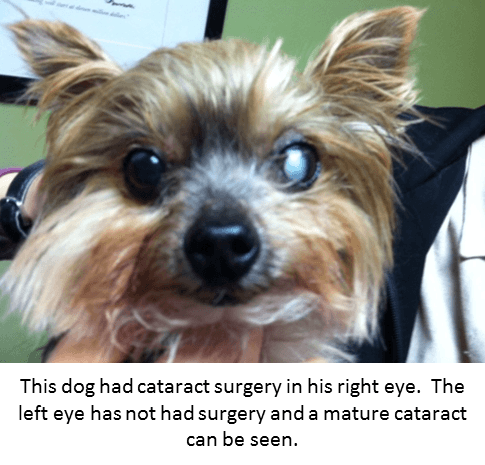
What is a cataract?
A cataract is an opacification of the normally crystal clear lens inside of the eye. Like the lens of a camera, the lens helps to focus and allow for optimal vision. A small cataract may have no significant affect on an animal’s vision, however, a large cataract can cause complete vision loss.
A true opacity of the lens – a cataract – is different from a normal aging process within the lens called lenticular sclerosis (also known as nuclear sclerosis). With lenticular sclerosis, near vision is affected but in most dogs, there is no obvious behavior change. However, if a cataract progresses, vision and behavior changes begin to affect behavior and quality of life.
Why does my dog have a cataract and how does it affect him/her?
Cataracts can be inherited or can develop secondary to diabetes mellitus, chronic inflammation within the eye or trauma. Other causes of cataracts are less common. In cats, cataracts are most commonly secondary to chronic intraocular inflammation. As cataracts mature, in addition to causing vision loss, they can lead to secondary often painful problems within the eye such as persistent inflammation (uveitis) or glaucoma.
What is the treatment for a cataract(s)?
At this time, there is no topical or oral medication that has been shown scientifically to reverse or slow the progression of cataract formation. Cataract extraction surgery has been performed in animals for many years with a high degree of successful improvement of vision. The procedure used in animals is almost exactly the same as that used in people. The job of the veterinary ophthalmologist is to perform a thorough ophthalmic examination to determine whether an animal is good candidate for cataract surgery.
What is the prognosis for cataract surgery and what can I expect?
The success rate for cataract surgery in animals is 90-95%. Cataract surgery requires general anesthesia and is typically done on an outpatient basis. Most dogs will require eye drops beginning about 1 week prior to surgery and for the first few months following surgery. Oral medication will also be used post-operatively. An e-collar is worn for about 2 weeks after surgery. Significant improvement in vision is typically obvious within the first 24 hours after surgery.
MVA 5K
Every year Metropolitan Veterinary Associates organizes a 5K run/walk (leashed participants are encouraged to join) with all proceeds benefiting local non-profit animal rescue organizations. To learn more about the MVA5K click here.
Save A Life
There are very few national animal blood banks. Your dog may be able to save a life by donating blood. Learn more about it today by clicking here.
Ask A Question
It’s important that our patients and their families can get to know our doctors and the facility. Ask us a question about anything for a chance to see it answered on our blog.